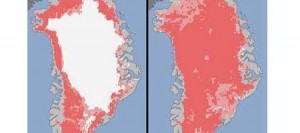 Almost all of Greenland’s surface ice cover has melted at some point this summer – twice as much as usual. It’s the largest melt ever seen in more than 30 years of satellite observations.
Almost all of Greenland’s surface ice cover has melted at some point this summer – twice as much as usual. It’s the largest melt ever seen in more than 30 years of satellite observations.
This month, 97 percent of Greenland’s ice cover, from its thin, low-lying coastal edges to its two-mile-thick center, experienced some degree of melting at its surface.
On average in the summer, about half of the surface of Greenland’s ice sheet melts. At high elevations, most of that melt water quickly refreezes, while, near the coast, some is retained by the ice sheet and the rest is lost to the ocean.
Researchers haven’t yet determined whether this year’s extensive melt event will affect the overall volume of ice loss this summer and contribute to sea level rise.
“The Greenland ice sheet is a vast area with a varied history of change. This event, combined with other natural but uncommon phenomena, such as the large calving event last week on Petermann Glacier, are part of a complex story,” says Tom Wagner, NASA’s cryosphere program manager in Washington.
“Satellite observations are helping us understand how events like these may relate to one another as well as to the broader climate system.”
When Son Nghiem of NASA’s Jet Propulsion Laboratory was analyzing radar data from the Indian Space Research Organisation’s (ISRO) Oceansat-2 satellite last week, he noticed that most of Greenland appeared to have undergone surface melting on July 12.
“This was so extraordinary that at first I questioned the result: was this real or was it due to a data error?” he says.
But data from the Moderate-resolution Imaging Spectroradiometer (MODIS) on NASA’s Terra and Aqua satellites and the Special Sensor Microwave Imager/Sounder on a US Air Force meteorological satellite confirmed the results.
The melting spread quickly: from about 40 percent on July 8, to 97 percent on July 12. This coincided with an unusually strong ridge of warm air over Greenland – one of a series that has dominated Greenland’s weather since the end of May.
“Ice cores from [Summit Station in central Greenland] show that melting events of this type occur about once every 150 years on average. With the last one happening in 1889, this event is right on time,” says Lora Koenig, a Goddard glaciologist and a member of the research team analyzing the satellite data.
“But if we continue to observe melting events like this in upcoming years, it will be worrisome.”
TGDAILY
Leave a Reply
You must be logged in to post a comment.